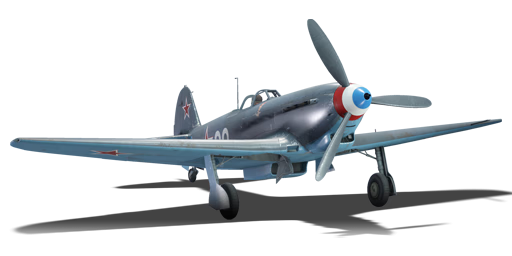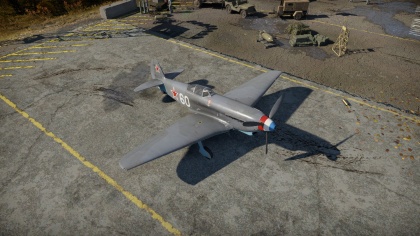Challe's Yak-9T (France)
Contents
Description
Challe's Yak-9T is a Rank III French fighter with a battle rating of 3.7 (AB), 4.3 (RB), and 4.0 (SB). It was introduced in Update 1.73 "Vive la France", released later to commemorate the 75th anniversary of the French-Soviet squadron "Normandie-Niemen" on 24 November 2017. The plane was modeled after the one used by French pilot René Challe.
Challe's Yak-9T has so far been made available only during the 75th anniversary event for the Normandie Niemen Soviet-French squadron as a purchasable premium.
General info
Flight Performance
| Characteristics | |||||||
|---|---|---|---|---|---|---|---|
| Stock | |||||||
| Max Speed (km/h at ?,000 m) |
Max altitude (meters) |
Turn time (seconds) |
Rate of climb (meters/second) |
Take-off run (meters) | |||
| AB | RB | AB | RB | AB | RB | ||
| ? | ? | ?,000 | ??.? | ??.? | ??.? | ??.? | ??? |
| Upgraded | |||||||
| Max Speed (km/h at ?,000 m) |
Max altitude (meters) | Turn time (seconds) | Rate of climb (meters/second) |
Take-off run (meters) | |||
| AB | RB | AB | RB | AB | RB | ||
| ? | ? | ?,000 | ??.? | ??.? | ?.? | ?.? | ? |
Details
| Features | ||||
|---|---|---|---|---|
| Combat flap | Take-off flap | Landing flap | Air brakes | Arrestor gear |
| X | X | X | X | X |
| Limits | ||||
|---|---|---|---|---|
| Wing-break speed (km/h) |
Gear limit (km/h) |
Combat flap (km/h) |
Max Static G | |
| + | - | |||
| ??? | ??? | ??? | ~?? | ~? |
| Optimal velocities | |||
|---|---|---|---|
| Ailerons (km/h) |
Rudder (km/h) |
Elevators (km/h) |
Radiator (km/h) |
| < ??? | < ??? | < ??? | > ??? |
| Compressor (RB/SB) | ||
|---|---|---|
| Setting 1 | ||
| Optimal altitude | 100% Engine power | WEP Engine power |
| ?,??? m | ??? hp | ?,??? hp |
Survivability and armour
- 64 mm Bulletproof glass in cockpit front and rear.
- 8 mm Steel plate in the pilot's seat.
Armaments
Offensive armament
The D.371 is armed with:
- 1 x 37 mm NS-37 cannon, nose-mounted (30 rpg = 30 total)
- 1 x 12.7 mm Berezin UB machine gun (200 rpg = 200 total)
Usage in the battles
The Yakovlev 9-T or Yak-9 as it is most popularly referred to in game, being the most popular of the Yak 9 variants, is best played differently depending on the situation the pilot finds him/herself in.
To begin, make sure that you take off and immediately climb. A twenty degree angle may be too much to handle depending on the amount of upgrades purchased on the aircraft, so a fifteen degree climb is recommended. With it, the pilot keeps much needed speed and agility. altitude advantage over your opponent is always preferred, and most pilots of the tier that the Yak 9T fights, do not choose to climb over 2,000 Meters (6,561 feet) A good altitude to climb to is 3,000 Meters (9,842 feet) In this way altitude advantage is achieved. Be advised this will not always be the case and some enemies will climb above you, if this happens, try to make them bleed energy until they are slower than you and turn fight them.
At high altitude, the Yak 9T is best suited to energy fighting, which means using the Yak's good energy retention to zoom at an opponent, shoot at them, and then climb up and turn back to your opponent and give chase. They Yak at mid to low altitude is best suited to turn-fighting against all nations except for the Japanese. If facing the Japanese, use the same energy fight tactics as stated above, as Japanese planes will be unable to give chase due to low energy retention of their lightweight aircraft. The Yak-9T comes equipped with flaps, it is critical you use them, as performance is greatly increased in a turn-fight with them opened.
The Yak 9T and all Yak's suffer from constant engine overheat, properly watching this temperature is critical, because if let go too long, the engine will die and the Yak falls fast. Keep eyes on temp at all times. Best advice is to keep throttle at 90% or lower when not in combat. The Yak-9T is best suited to colder maps, if on a hot map, gain altitude and cruise at 85-90% throttle.
Manual Engine Control
| MEC elements | ||||||
|---|---|---|---|---|---|---|
| Mixer | Pitch | Radiator | Supercharger | Turbocharger | ||
| Oil | Water | Type | ||||
| Not controllable | Controllable Automatic pitch |
Controllable | Not controllable | Combined | Controllable | Not controllable |
Modules
| Tier | Flight performance | Survivability | Weaponry |
|---|---|---|---|
| IA | |||
| II | |||
| III | |||
| IV |
Pros and cons
Pros:
- Cannon is quite accurate and powerful
- Has 30 shells for the 37 mm and reasonably high rate of fire compared to it's caliber
- Decent maneuverability
- Cannon can knock out medium tanks with several hits in the side or rear.
Cons:
- Once the 37 mm runs out of ammo quickly; afterwards just have a single 50. Cal MG
- 37 mm has high recoil
- Lousy high-altitude performance.
History
Describe the history of the creation and combat usage of the aircraft in more detail than in the introduction. If the historical reference turns out to be too big, take it to a separate article, taking a link to an article about the vehicle and adding a block "/ historical reference" (example: https://wiki.warthunder.com/Name-vehicles/historical reference) and add a link to it here using the main template. Be sure to include links to sources at the end of the article.
Media
An excellent addition to the article will be video guides, as well as screenshots from the game and photos.
Read also
Links to the articles on the War Thunder Wiki that you think will be useful for the reader, for example,
- reference to the series of the aircraft;
- links to approximate analogues of other nations and research trees.
Sources
Paste links to sources and external resources, such as:
- topic on the official game forum;
- page on aircraft encyclopedia;
- other literature.





